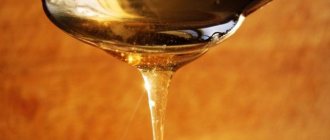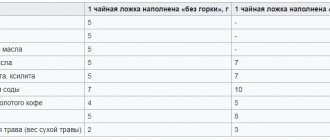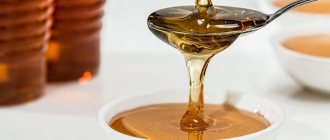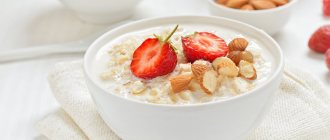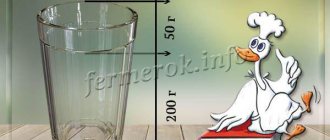Oatmeal is a healthy breakfast beloved by many, which can be prepared in just a few minutes, so for those who are watching calories and need to accurately measure oatmeal in grams without scales, it will be useful to know how many grams of oatmeal are in a tablespoon and a teaspoon.
Important: the weight and size of dry oat flakes may not differ much depending on the manufacturer, so the average values are given below.
How many grams are in a tablespoon of oatmeal (oatmeal)?
1 tablespoon holds 16 grams of oatmeal (heaped)
One tablespoon contains 12 grams of oatmeal (without a slide)
In the table below, the calculations were carried out with ordinary dry oatmeal of the Hercules type, which is the most popular in our latitudes.
| Type of spoon | Weight in grams | Calorie content of a spoon |
| A heaping tablespoon of oatmeal is | 16 grams | 56 calories |
| A level tablespoon of oatmeal is | 12 grams | 42 calories |
| A heaping teaspoon of oatmeal is | 6 grams | 21 calories |
| A level teaspoon of oatmeal is | 4 grams | 14 calories |
Table weight of prepared (raw) oatmeal in a spoon
| Type of spoon | Weight in grams |
| A heaped tablespoon of boiled oatmeal is | 35 grams |
| A level tablespoon of boiled oatmeal is | 25 grams |
| A heaped teaspoon of boiled oatmeal is | 15 grams |
| A level teaspoon of boiled oatmeal is | 7 grams |
The weight of the finished oatmeal may vary! It all depends on how thick or thin the oatmeal you prepared. In our table, we took the average value.

Attention! Oatmeal (oatmeal) is not only porridge, but rather it is the fastest way to get a tasty and healthy dish. Oatmeal is even used in cosmetology and medicine.
How many grams of oatmeal are in a spoon?
- 30 grams of oatmeal is how many spoons? 30 g of oatmeal is 2 tablespoons of oatmeal (heaped)
- 40 grams of oatmeal is how many spoons? 40 g of oatmeal is 2 tablespoons of dry oatmeal (heaped) plus 2 teaspoons of oatmeal (heaped)
- 50 grams of oatmeal is how many spoons? 50 g of oatmeal is 3 tablespoons of oatmeal (heaped) plus 1 teaspoon of oatmeal (heaped)
- 60 grams of oatmeal is how many spoons? 60 g of oatmeal is 4 tablespoons of oatmeal (heaped)
- 70 grams of oatmeal is how many spoons? 70 g of oatmeal is 4 tablespoons of oatmeal (heaped) plus 1 teaspoon of oatmeal (heaped)
- 75 grams of oatmeal is how many spoons? 75 g of oatmeal is 5 tablespoons of oatmeal (heaped)
- 80 grams of oatmeal is how many spoons? 80 g of oatmeal is 5 tablespoons of oatmeal (heaped) plus 1 teaspoon (heaped)
- 85 grams of oatmeal is how many spoons? 85 g of oatmeal is 5 tablespoons of oatmeal (heaped) plus 2 teaspoons of oatmeal (heaped)
- 100 grams of oatmeal ? 100 g of oatmeal is 6 tablespoons of oatmeal (heaped) plus 2 teaspoons of oatmeal (heaped)
- 150 grams of oatmeal is how many spoons? 150 g of oatmeal is 10 tablespoons of oatmeal (with a small slide)
- 170 grams of oatmeal is how many spoons? 170 g of oatmeal is 11 tablespoons of oatmeal (heaped) plus 1 teaspoon of oatmeal (heaped)
- 200 grams of oatmeal is how many spoons? 200 g of oatmeal is 13 tablespoons of oatmeal (heaped) plus 1 teaspoon of oatmeal (heaped)
- 250 grams of oatmeal is how many spoons? 250 g of oatmeal is 16 tablespoons of oatmeal (heaped) plus 2 teaspoons of oatmeal (heaped)
Benefits of oatmeal
Oatmeal flakes contain a large amount of vitamins and fiber. This porridge stabilizes cholesterol levels and is useful for people suffering from high blood sugar.
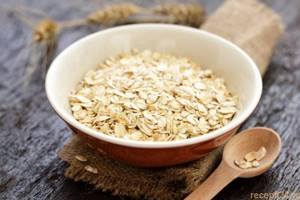
| Daily value per 100 g. | ||
| Vitamin E | 0.4 mg | 2,9% |
| Vitamin K | 2.0 mcg | 1,7% |
| Vitamin B1 | 0.5 mg | 38,3% |
| Vitamin B2 | 0.2 mg | 11,9% |
| Vitamin B3 | 1.1 mg | 7,0% |
| Vitamin B4 | 40.4 mg | 8,1% |
| Vitamin B5 | 1.1 mg | 22,4% |
| Vitamin B6 | 0.1 mg | 7,7% |
| Vitamin B9 | 32.0 mcg | 8,0% |
| Daily value per 100 g. | ||
| Calcium | 52.0 mg | 5,2% |
| Iron | 4.3 mg | 42,5% |
| Magnesium | 138.0 mg | 34,5% |
| Phosphorus | 410.0 mg | 58,6% |
| Potassium | 362.0 mg | 7,7% |
| Sodium | 6.0 mg | 0,5% |
| Zinc | 3.6 mg | 33,1% |
| Copper | 0.4 mg | 43,4% |
| Manganese | 3.6 mg | 157,8% |
| Selenium | 28.9 mcg | 52,5% |
| Daily value per 100 g. | ||
| Tryptophan | 0.182 g | 22,8% |
| Threonine | 0.382 g | 15,9% |
| Isoleucine | 0.503 g | 25,2% |
| Leucine | 0.980 g | 21,3% |
| Lysine | 0.637 g | 15,5% |
| Methionine | 0.207 g | 11,5% |
| Cystine | 0.455 g | 25,3% |
| Phenylalanine | 0.665 g | 15,1% |
| Tyrosine | 0.395 g | 9,0% |
| Valin | 0.688 g | 27,5% |
| Arginine | 0.850 g | 13,9% |
| Histidine | 0.275 g | 13,1% |
| Alanin | 0.563 g | 8,5% |
| Aspartic | 1.217 g | 10,0% |
| Glutamic | 2.830 g | 20,8% |
| Glycine | 0.642 g | 18,3% |
| Proline | 0.451 g | 10,0% |
| Serin | 0.705 g | 8,5% |
Oatmeal is the best start to the day for those who take care of their body, as well as the health of their child.
There are 379 kcal per 100 grams of product. 13.2 g protein, 6.5 g fat, 67.7 g carbohydrates.
Oatmeal recipe (30 g). Calorie, chemical composition and nutritional value.
Nutritional value and chemical composition of “Oatmeal (30 g).”
The table shows the nutritional content (calories, proteins, fats, carbohydrates, vitamins and minerals) per 100 grams of edible portion.
| Nutrient | Quantity | Norm** | % of the norm in 100 g | % of the norm in 100 kcal | 100% normal |
| Calorie content | 85.9 kcal | 1684 kcal | 5.1% | 5.9% | 1960 |
| Squirrels | 3.7 g | 76 g | 4.9% | 5.7% | 2054 g |
| Fats | 2.2 g | 56 g | 3.9% | 4.5% | 2545 g |
| Carbohydrates | 12.9 g | 219 g | 5.9% | 6.9% | 1698 g |
| Organic acids | 0.1 g | ~ | |||
| Alimentary fiber | 1 g | 20 g | 5% | 5.8% | 2000 g |
| Water | 77.5 g | 2273 g | 3.4% | 4% | 2933 g |
| Ash | 0.6612 g | ~ | |||
| Vitamins | |||||
| Vitamin A, RE | 12.4 mcg | 900 mcg | 1.4% | 1.6% | 7258 g |
| Retinol | 0.01 mg | ~ | |||
| beta carotene | 0.005 mg | 5 mg | 0.1% | 0.1% | 100000 g |
| Vitamin B1, thiamine | 0.077 mg | 1.5 mg | 5.1% | 5.9% | 1948 |
| Vitamin B2, riboflavin | 0.094 mg | 1.8 mg | 5.2% | 6.1% | 1915 |
| Vitamin B4, choline | 13.26 mg | 500 mg | 2.7% | 3.1% | 3771 g |
| Vitamin B5, pantothenic | 0.213 mg | 5 mg | 4.3% | 5% | 2347 g |
| Vitamin B6, pyridoxine | 0.069 mg | 2 mg | 3.5% | 4.1% | 2899 g |
| Vitamin B9, folates | 6.685 mcg | 400 mcg | 1.7% | 2% | 5984 g |
| Vitamin B12, cobalamin | 0.225 mcg | 3 mcg | 7.5% | 8.7% | 1333 g |
| Vitamin C, ascorbic acid | 0.55 mg | 90 mg | 0.6% | 0.7% | 16364 g |
| Vitamin D, calciferol | 0.028 mcg | 10 mcg | 0.3% | 0.3% | 35714 g |
| Vitamin E, alpha tocopherol, TE | 0.27 mg | 15 mg | 1.8% | 2.1% | 5556 g |
| Vitamin H, biotin | 5.169 mcg | 50 mcg | 10.3% | 12% | 967 g |
| Vitamin RR, NE | 1.2247 mg | 20 mg | 6.1% | 7.1% | 1633 g |
| Niacin | 0.207 mg | ~ | |||
| Macronutrients | |||||
| Potassium, K | 137.08 mg | 2500 mg | 5.5% | 6.4% | 1824 |
| Calcium, Ca | 71.96 mg | 1000 mg | 7.2% | 8.4% | 1390 g |
| Magnesium, Mg | 28.88 mg | 400 mg | 7.2% | 8.4% | 1385 g |
| Sodium, Na | 31.68 mg | 1300 mg | 2.4% | 2.8% | 4104 g |
| Sera, S | 31.4 mg | 1000 mg | 3.1% | 3.6% | 3185 g |
| Phosphorus, P | 102.8 mg | 800 mg | 12.9% | 15% | 778 g |
| Chlorine, Cl | 74.49 mg | 2300 mg | 3.2% | 3.7% | 3088 g |
| Microelements | |||||
| Aluminium, Al | 28.1 mcg | ~ | |||
| Iron, Fe | 0.653 mg | 18 mg | 3.6% | 4.2% | 2757 g |
| Yod, I | 6.07 mcg | 150 mcg | 4% | 4.7% | 2471 g |
| Cobalt, Co | 1.292 mcg | 10 mcg | 12.9% | 15% | 774 g |
| Manganese, Mn | 0.6476 mg | 2 mg | 32.4% | 37.7% | 309 g |
| Copper, Cu | 82.75 mcg | 1000 mcg | 8.3% | 9.7% | 1208 g |
| Molybdenum, Mo | 2.809 mcg | 70 mcg | 4% | 4.7% | 2492 g |
| Tin, Sn | 7.3 mcg | ~ | |||
| Selenium, Se | 1.124 mcg | 55 mcg | 2% | 2.3% | 4893 g |
| Strontium, Sr | 9.55 mcg | ~ | |||
| Fluorine, F | 46.91 mcg | 4000 mcg | 1.2% | 1.4% | 8527 g |
| Chromium, Cr | 1.12 mcg | 50 mcg | 2.2% | 2.6% | 4464 g |
| Zinc, Zn | 0.7472 mg | 12 mg | 6.2% | 7.2% | 1606 g |
| Digestible carbohydrates | |||||
| Starch and dextrins | 10.028 g | ~ | |||
| Mono- and disaccharides (sugars) | 2.8 g | max 100 g | |||
| Essential amino acids | |||||
| Arginine* | 0.1382 g | ~ | |||
| Valin | 0.1062 g | ~ | |||
| Histidine* | 0.0455 g | ~ | |||
| Isoleucine | 0.0758 g | ~ | |||
| Leucine | 0.1197 g | ~ | |||
| Lysine | 0.0792 g | ~ | |||
| Methionine | 0.0236 g | ~ | |||
| Methionine + Cysteine | 0.0758 g | ~ | |||
| Threonine | 0.0725 g | ~ | |||
| Tryptophan | 0.0371 g | ~ | |||
| Phenylalanine | 0.1011 g | ~ | |||
| Phenylalanine+Tyrosine | 0.1837 g | ~ | |||
| Nonessential amino acids | |||||
| Alanin | 0.091 g | ~ | |||
| Aspartic acid | 0.1719 g | ~ | |||
| Glycine | 0.1921 g | ~ | |||
| Glutamic acid | 0.3674 g | ~ | |||
| Proline | 0.1213 g | ~ | |||
| Serin | 0.0961 g | ~ | |||
| Tyrosine | 0.0843 g | ~ | |||
| Cysteine | 0.0539 g | ~ | |||
| Sterols (sterols) | |||||
| Cholesterol | 4.49 mg | max 300 mg | |||
| Saturated fatty acids | |||||
| Saturated fatty acids | 1.2 g | max 18.7 g | |||
| 14:0 Miristinovaya | 0.0034 g | ~ | |||
| 16:0 Palmitinaya | 0.2208 g | ~ | |||
| 18:0 Stearic | 0.0101 g | ~ | |||
| Monounsaturated fatty acids | 0.3624 g | min 16.8 g | 2.2% | 2.6% | |
| 18:1 Oleic (omega-9) | 0.3607 g | ~ | |||
| Polyunsaturated fatty acids | 0.3927 g | from 11.2 to 20.6 g | 3.5% | 4.1% | |
| 18:2 Linolevaya | 0.3843 g | ~ | |||
| 18:3 Linolenic | 0.0084 g | ~ | |||
| Omega-6 fatty acids | 0.4 g | from 4.7 to 16.8 g | 8.5% | 9.9% |
The energy value of Oatmeal (30 g) is 85.9 kcal.
Primary Source: Created in the application by the user. Read more.
** This table shows the average levels of vitamins and minerals for an adult. If you want to know the norms taking into account your gender, age and other factors, then use the “My Healthy Diet” application.
Recipe
The ratio of oatmeal to water is 1.5:2. That is, for 1.5 cups of cereal you need 2 cups of water.
- We need 2 cups of oatmeal, a liter of water, butter and salt and sugar to taste.
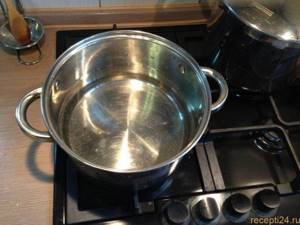
- As soon as the water in the pan begins to boil, pour the flakes into the water and add salt and sugar to taste.

- While cooking, slowly stir the flakes until completely cooked. If you don't stir the porridge, it will burn on the pan. Cooking time 15 - 20 minutes. Time may vary due to flake size (whole oats) and heat level. Large flakes take longer to cook, but also contain more vitamins. Whole grains are cooked for up to 40 minutes.

- When the mass in the pan begins to look like porridge, turn off the gas and add butter to taste.

How to choose oatmeal
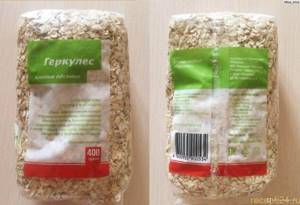
Instant cereal contains fewer vitamins and minerals due to processing during the manufacturing process. The glycemic index of such products is high and therefore the rate of digestion of carbohydrates and their conversion into sugar is high.
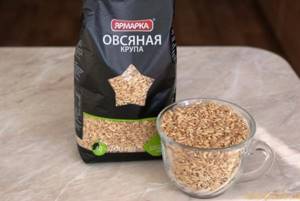
If you are watching your figure and health, then oatmeal should be made only from whole grain oatmeal. This is a cereal and visually it looks nothing like flakes. Also, if you want to monitor your health, but cook the cereal for too long, look for crushed cereal on the store shelves. It contains less fiber, but it is better than cereal cooked in 5 minutes.
Scottish porridge recipe
Porridge - this dish has become national in Scotland. Liquid oatmeal, cooked only from whole or crushed oatmeal. The cooking process itself is no different, but sugar or salt and other additives are not added to this porridge. Porridge is prepared exclusively with water. During the cooking process, salt, oil and other additives prevent the oatmeal from revealing its flavor.
The Scots know a lot about oatmeal and therefore more than 80% of the national cuisine uses oatmeal.
- October 12, 2018
- Second courses
- Garfutdinova Svetlana
There is a place for perfectionism in life. As well as diets and proper nutrition. For example, the nutritionist ordered, and hinted at a healthy lifestyle: take 100 grams of oatmeal in the morning on an empty stomach. It’s also good if you allow it to be brewed with boiling water (worse - if you use soy milk).
What if you are an obedient person? They said one hundred grams means one hundred grams, not a gram more, not a gram less. So what, run for a pharmacy scale? No! Read our article.
Oatmeal and its properties
For many centuries, oatmeal continues to be one of the most popular dietary and healthy dishes. It is prepared with water or milk from cereal or flour . Oatmeal is obtained from oats, which are a young crop compared to wheat.
To get the oat flakes we are used to, oat grains are first ground and then flattened. After this, the oil is squeezed out, the rest of the product is subjected to heat treatment. All processing methods used help to obtain grain that is more saturated, aromatic and crispy. The composition of flakes differs from grains, but only slightly. Oatmeal and bran, which are most often used in production, are also obtained from the grains.
Oatmeal is nutritious and healthy . Depending on the type of oatmeal, the cooking time will vary. You can diversify them with various products:
- fresh fruits and berries;
- dried apricots;
- raisins;
- honey, etc.
Oatmeal contains a large amount of vegetable protein and carbohydrates. Despite this, it is considered a healthy dietary dish. The product also contains a lot of carbohydrates, which does not prevent it from being easily absorbed by the body. Regular use of this product has a positive effect on health and appearance.
Oatmeal or rolled oats?
The easiest way to measure 100 grams of oatmeal is with tablespoons. They are always at hand. So, 100 grams of oatmeal is how many spoons?

Oatmeal is also different, so we have prepared what you need to measure with spoons:
- dry oatmeal;
- dry oat flakes.
And, of course, a tablespoon.
So, we have 100 grams of oatmeal and 100 grams of dry oat flakes in separate containers. Carefully scoop them out and pour them into another container with a tablespoon. But spoons come with a slide and without a slide. Let's try both options.
Calorie content of oatmeal per 100 grams
When prepared, oatmeal with water or milk is a tasty and healthy product. All cereals are high in carbohydrates. The calorie content of dry oatmeal is 342 calories per 100 grams of cereal:
- proteins – 12.3 g; 49.2 kcal;
- fats – 6.11 g; 54.9 kcal;
- carbohydrates – 59.5 g; 238 kcal;
- dietary fiber – 8 gr.
Ratio of BJU by weight in dry form:
- proteins – 15.3%;
- fats – 6.0%;
- carbohydrates – 78.8%.
All grains increase in size during cooking, so after cooking their energy value decreases. Now let's look at how this happens with oatmeal cooked in water and cooked in milk and how many calories they contain.
The calorie content of oatmeal cooked with clean water is 88 calories per 100 grams of finished product, of which:
- proteins – 3.0 g;
- fats – 1.7 g;
- carbohydrates – 15.0 g.
Currently, many oatmeal manufacturers produce instant products. In such quick dishes, the nutritional value is much higher, for example, in five-minute porridge, the calorie content will be 350 units per 100 grams , of which:
- proteins – 56 kcal;
- fats – 67.5 kcal;
- carbohydrates – 224 kcal.
Judging by the indicators, the calorie content of quick porridge exceeds the nutritional value of boiled porridge by 5 times. Fans of five-minute porridges should think about this. It's better to spend some time making traditional oatmeal and eat a lower calorie product.
Oatmeal cooked with milk has slightly more calories. There are 105 calories per 100 grams of milk oatmeal , of which:
- proteins – 3.2 g;
- fats – 4.3 g;
- carbohydrates – 14.2 g.
With the help of such porridge, complex carbohydrates enter the body. They are processed into glucose over a long period of time to maintain the body’s active vital functions.
Milk and water porridge can be even tastier if you add raisins, dried apricots, prunes, nuts, and flavor them with butter. With such additives, its energy value will increase depending on the type of product.
Dry product in level tablespoons
The second option is without a slide. Let's see, 100 grams of oatmeal is how many tablespoons.
Hint: it is more convenient to level the level of the spoon using a knife. Scoop up the cereal and use a knife blade to run along the edges, “cutting off” the excess. The spoon will be filled exactly to the brim.
So, let's start the process. We scoop it up, remove the excess with a knife, pour it over. And so on until the containers are empty. At the same time, we carefully keep count of our spoons.
What happened in the end? Containers with 100 grams of our initial dry content are equal to:
- 8 tbsp. spoons of dry cereal;
- 9 tbsp. spoons of dry oatmeal.
But maybe you shouldn’t bother with these tablespoons every morning, with or without a slide? Maybe to save time, let's cook oatmeal for the whole week? And when it’s ready, let’s measure 100 grams of oatmeal into a plate, wash it down with a cup of coffee and run about our business? Do you agree? Then we move on to measurement.


